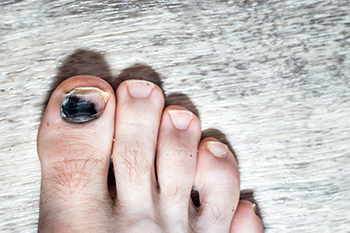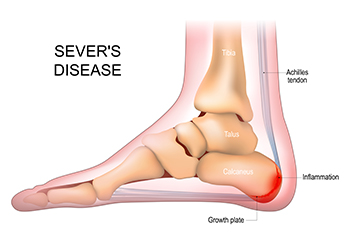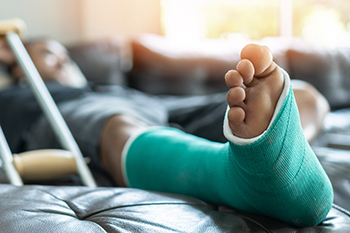Items filtered by date: August 2023
Causes of Tennis Toe

Tennis toe, also known as "subungual hematoma" or "runner's toe," is a common condition among athletes, particularly those involved in sports like tennis, soccer, football, squash, racquetball, basketball, running, and skiing. It's characterized by throbbing pain and a blue/black discoloration of the toenail caused by bleeding under the nail plate. The root cause of tennis toe lies in repetitive pressure and friction on the toenail when the toe is jammed against the front of the shoe's toe box. This often occurs during sudden stops, direction changes, and pivoting movements. The resulting damage causes blood to pool beneath the nail, leading to pain and discoloration, most commonly affecting the big toe. To prevent tennis toe, it is a good idea to keep toenails clipped short to minimize pressure and friction. Opt for well-fitting shoes, with some athletes recommending steel-toed tennis shoes for added protection. Consider playing on natural surfaces like grass or clay courts instead of synthetic ones. Tennis toe is a painful condition resulting from repeated toe trauma. If symptoms persist, it is suggested that you make an appointment with a chiropodist for any necessary treatment.
Toe pain is common and can have a variety of causes. Causes can range from a broken toe to an ingrown toenail. Many types of toe pain can be corrected, but any toe pain that inhibits your activities for an extended period should be discussed with a chiropodist. If you suffer from toe pain, please consult with one of the chiropodists from Complete Family Footcare & Therapy. Our clinicians can help you maintain the health of your feet.
Common Causes of Toe Pain
- Trauma or fracture
- Cuts, sores, or bruises
- Rheumatoid arthritis
- Gout
- Turf Toe
- Morton’s neuroma
- Blisters
- Corns
- Bunions
- Hammertoes
- Ingrown toenails
- Plantar warts
- Athlete’s Foot
Symptoms of Toe Pain
- Toe deformity
- Burning
- Numbness
- Toenail deformity
- Wart or ulcer
- Swelling
- Redness
When to See a Chiropodist
- Bleeding or severe swelling
- Trauma, such as a broken bone
- Discoloration or extreme swelling
- Inability to bear weight
- Persistent pain
- Wounds that won’t heal
Diagnosis of Toe Pain
A chiropodist can conduct a thorough examination of the painful toe or toes in order to determine the best course of treatment. The exam may include assessing the tenderness of the area, taking an X-ray or other diagnostic test, or assessing your gait and range of motion. A discussion of what led to the advanced pain issue may follow. Included will likely be a health history, as well as a list of medications you are taking and other previous injuries you may have sustained.
Treatment for Toe Pain
With such a wide range of possible causes for toe pain, treatment can be varied in scope and length. Sometimes, the chiropodist will recommend lifestyle and activity changes. In cases of trauma or other injuries, X-rays or imaging tests will likely be used to determine the severity of the problem, particularly if any bones have been broken. Treatment may also include injections of pain-relief medication or anti-inflammatory drugs. Certain injuries will require the splinting, bracing, or wrapping of injured toes. Orthotics or special shoes may be prescribed in cases of bone deformities and gait issues. Removal of warts, calluses, and corns may be needed. In other cases, such as with patients who have diabetes or rheumatoid arthritis, ongoing treatment may be required to avoid more serious problems.
Sever’s Disease in Children

Sever's disease is a common source of heel discomfort during childhood and early adolescence, particularly among active children engaged in running and jumping activities. This condition arises from strain on the heel bone caused by the calf muscle tendon's attachment. Children might experience limping and pain during various activities, affecting one or both feet. While there is no specific remedy for Sever’s disease, symptoms can be managed. Temporarily discontinuing the triggering activity, opting for comfortable shoes with heel inserts, and engaging in daily calf stretches can provide relief. Typically, pain subsides within 6 to 12 months, though it may persist for up to two years. The condition should not have long-term effects. If a child complains of heel pain, it is suggested that you make an appointment with a chiropodist for a proper diagnosis and treatment.
Sever’s disease typically affects young children and teenagers. If your child complains of foot pain, please consult with one of the chiropodists from Complete Family Footcare & Therapy. Our clinicians will assess your condition and provide you with quality foot and ankle treatment.
What Is Sever’s Disease?
Sever’s disease, also known as calcaneal apophysitis, is an inflammation of the growth plate in the heel bone. It is typically caused by overuse due to repetitive activities such as running, jumping, and playing certain sports. This condition most frequently affects children between the ages of 8 and 14.
Symptoms
Symptoms of Sever’s disease include:
Pain in the back or bottom of the heel
Pain when the sides of the heel are squeezed
Limping or walking on tiptoes to avoid putting pressure on the heel
Difficulty running, jumping, or participating in usual activities
Fatigue
Diagnosis
Sever’s disease is diagnosed by taking a thorough medical history and performing a physical examination. Imaging studies, such as an X-ray, can help rule out other injuries like a fracture.
Treatment
Sever’s disease typically heals without any long-term complications. Treatment involves resting the affected foot by reducing typical activities, wearing orthotics to support the foot, immobilizing the affected foot, taking medications to reduce pain and inflammation, and stretching the foot.
If you have any questions, please feel free to contact our offices located in . We offer the newest diagnostic and treatment technologies for all your foot care needs.
Do’s and Don’ts for Dealing With Blisters

A blister can be a minor annoyance or a major source of pain. Understanding how to deal with blisters on the foot can make a difference in the outcome. A blister is nature’s way of protecting skin that is being injured due to friction. It appears as a sort of bubble on the surface of the skin that is filled with fluid. When a blister forms, it is thought to be a good idea to apply a washcloth with cold water over it to reduce the pain and swelling. Next, put zinc oxide or other skin-drying medication on the affected area to help keep it dry. Popping the blister or picking at the skin is not suggested, as this may lead to infection and increase pain. If the area has attracted dirt or becomes filled with pus, it is essential to see a chiropodist who can clean the wound safely. It is thought best to avoid soap or detergents that can irritate the already tender skin of the blister. Placing a bandage on the blister is not recommended as it may further tear the skin. Instead, many runners use petroleum jelly on their feet before starting an activity to reduce the chances of forming a blister. Wearing socks that wick away moisture is another deterrent to blister formation. If you have a particularly painful or infected blister, it is suggested that you make an appointment with a chiropodist.
Blisters can usually be treated at home, however, if you have recurring blisters or experience significant discomfort or pain, please consult with one of the chiropodists from Complete Family Footcare & Therapy. Our clinicians will assess your condition and provide you with quality foot and ankle treatment.
What Is a Blister?
A blister is a small pocket of fluid in the upper skin layers and is one of the body’s natural responses to injury or pressure. Blisters can also result from burns, fungal or viral skin infections, and the feet are particularly prone due to ill-fitting footwear and friction. Friction on the skin causes the upper layer of skin to separate from the lower layers. The space that this separation creates then becomes filled with a liquid called serum, which protects the lower layers of skin.
Treatment
If you notice a blister on your foot, you can cover it with a soft bandage or dressing to protect it. Popping the blister is discouraged. Doing so exposes the raw skin underneath it to bacteria and also raises the risk of infection. If a blister pops naturally, let it drain before covering it with a bandage. Blisters usually heal on their own or with home treatment, however, if your blister is recurring, very painful, or appears infected, it is recommended that you see a chiropodist for treatment.
Prevention
You can help to prevent blisters by wearing comfortable, well-fitted shoes. Keep your feet dry by wearing moisture-wicking socks and dust your feet with talcum powder if they tend to get sweaty. If you have areas on your feet that are more susceptible to blisters, you might be able to prevent the blister from forming by covering it with a pad.
If you have any questions, please feel free to contact our offices located in . We offer the newest diagnostic and treatment technologies for all your foot care needs.
Symptoms and Effective Treatments for a Broken Foot

A broken foot can be a painful and distressing experience, necessitating immediate attention for a swift recovery. Common symptoms include intense pain, swelling, bruising, and difficulty walking or bearing weight. In some cases, the affected foot may appear misshapen or visibly out of alignment. When dealing with a suspected broken foot, it's essential to seek medical attention promptly. A chiropodist will conduct a physical examination, possibly followed by X-rays or other imaging tests to confirm the diagnosis. Treatment options vary, based on the severity and location of the fracture. Pain management, rest, and elevation are crucial aspects of recovery. A broken foot demands patience and compliance with the treatment plan and it is suggested that you confer with a chiropodist who can guide you toward a full recovery and a return to normal activities as soon as possible.
A foot fracture is a crack or break in a foot bone, often caused by repetitive stress on the foot or a high-impact foot injury. If you’re suffering from foot pain, please consult with one of the chiropodists from Complete Family Footcare & Therapy. Our clinicians can help you maintain the health of your lower limbs and your mobility.
Symptoms
Pain
Bruising
Tenderness
Swelling
Difficulty walking
Deformity
Causes
Repetitive overloading of the foot
Having a previous fracture
Abnormal foot biomechanics
Changing training surfaces suddenly
Poor footwear
Osteoporosis
High-impact injury
Treatments
Rest
Ice
Elevation
Pain medication
Braces or other orthotics
Casts
Crutches
Surgery in more severe cases
If you have any questions, please feel free to contact our offices located in . We offer the newest diagnostic and treatment technologies for all your foot care needs.
Arthritis Can Cause Pain in the Feet and Ankles
Causes of Ingrown Toenails

An ingrown toenail can cause excruciating pain as the result of the toenail becoming embedded in the surrounding flesh of the toe. The most common location of an ingrown toenail is the big toe. Improper toenail hygiene is the most likely cause of developing an ingrown toenail. If the nail is too long or rounded, it may be more likely to grow into the skin. Cutting the nails short and straight across can help to eliminate this situation. Trauma, such as stubbing your toe or dropping something heavy on it, can also affect the way the nail grows and increase the likelihood of an ingrown toenail. Tight or ill-fitting footwear can be another contributing factor to the development of an ingrown toenail. If an ingrown toenail breaks the skin, it may become infected and make matters worse. In some cases the toe becomes more swollen and red, increasing the level of pain and throbbing. Pus and fluids may form at the site. Wearing shoes that continue to press on the sore toe can increase discomfort. Treating an ingrown toenail is usually a relatively simple process, and it is suggested that you consult a chiropodist who can effectively treat this condition.
Ingrown toenails may require medical attention. If you have significant pain or notice signs of infection from an ingrown toenail, please consult with one of the chiropodists from Complete Family Footcare & Therapy. Our clinicians will assess your condition and provide you with quality foot and ankle treatment.
What Is an Ingrown Toenail?
An ingrown toenail occurs when the edges of a toenail grow into the surrounding skin. The toenails of the big toe are usually affected, however, an ingrown toenail can happen on any toe. Sometimes, the area can become infected leading to potentially serious complications. The ingrown toenail may be caused by improper trimming of the toenail, wearing ill-fitting shoes, or injury to the nail.
Symptoms
The symptoms of an ingrown toenail include:
Pain
Swelling
Redness
Warmth
Pus or drainage from the affected nail or a fever may indicate an infection of the area.
Treatment
Treatment depends on the severity of the ingrown toenail. In less severe cases, home treatment may be adequate. Soaking the affected foot in warm water and gently lifting the nail from the skin with a piece of clean cotton can help. In more severe cases, you may need to use topical or oral antibiotics to treat an infection. Surgical removal of the ingrown toenail may be required if more conservative treatments fail.
Ingrown toenails may be prevented by wearing well-fitted shoes and properly trimming the toenails. Toenails should be trimmed straight across and not too short when using nail clippers.
If you have any questions, please feel free to contact our offices located in . We offer the newest diagnostic and treatment technologies for all your foot care needs.

